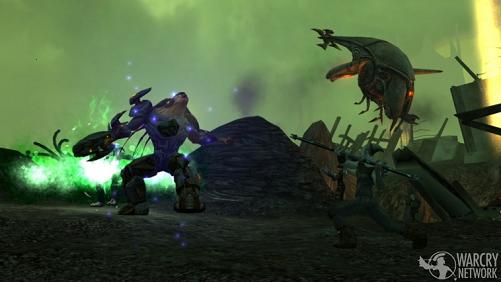

Three years ago, I wrote a piece about how people behave in a world that’s about to end. The world in question was Asheron’s Call 2 — one of those online-world games like World of Warcraft that hadn’t gotten enough subscribers to survive, so the developers were pulling the plug and turning the world off. As you can read here, it was a rather spooky and sad experience: Long-time players were mostly quietly mourning the imminent poofing of a place they’d long come to love. (I later learned about the concept of solsastalgia — the homesickness one feels not when one moves away, but when one’s home environment vanishes before one’s eyes — and realized this is precisely what the players were experiencing.)
Asheron’s Call 2 was the one of the first really big modern MMO worlds to shut down, so when the world actually came to an end, not much happened: The logged-in players got a perfunctory note from the developers, and then they were booted offline. But now that economic hard times are here, more online worlds are dying, and here’s the interesting thing: They’re realizing that they owe it to their long-time players to make it into a sort of event. Game designers are realizing that ending their world in a dramatically satisfying way is actually a very interesting logistical, ludogical, and emotional trick. In essence, we’re slowly seeing the emergence of eschatology as a design challenge.
Exhibit A is the Tabula Rasa, an online world that shut down in on Feb 28, 2009. Chris Remo of GameSetWatch wrote a terrific report of the end here — during which the designers engineered one last massive apocalyptic battle. The problem? So many players got wind of the impending badass finale that the servers slowed down under the load. So, much as you might expect in a real-world eschatalogical event, you got trippy time distortions, teleportation, and direct communications from the actual Creator.
Some players tried to predict what exactly would happen when the event began, and where it might be focused. Some seemed to want closure, frantically attempting to obtain the final pieces of certain equipment sets or to finish uncovering all areas of the world.Some thanked the developers for their continued support of the game until the final days; others cursed NCsoft for a perceived botched publishing job; many did both. A few stayed in character, attempting to rise to the occasion. “Men and women of the AFS, it has been an honor serving with you,” offered Nebalain.
By the afternoon, the West Coast server Hydra was the last server standing. As more and more of its citizenry logged on for the last hurrah, and foreign players from dead servers poured in to squeeze a few more hours out of the game, it became increasingly congested, buggy, and lag-ridden.
The intended scenario was indeed playing out not just in the game and the fiction but as a metagame: the active duty population swelled as humanity prepared to make its final stand, while the very world itself strained under the considerable weight and struggled to keep itself together …
Then, hundreds of players all over the world began being involuntarily teleported to an extraction location connected to the “Last Stand” area on Earth — a small string of camps in Manhattan serving as the final holdout against the invasion … The GMs reciprocated with server-wide missives: “ADMIN MESSAGE: As the clock ticks down, we’d like to take one last moment to thank everyone for playing. It’s been a fantastic ride, and we’re happy you stuck with us for the last year.” … Similar back-and-forth exchanges followed, with the GMs even breaking out that most classic of old internet chestnuts. “ADMIN MESSAGE: ALL YOUR BASE ARE BELONG TO US,” declared the server.
If you want to see more, here are a bunch of screenshots, and some videos of Tabula Rasa for the last five minutes until it ended.
Sometimes I wish the folks who made the Left Behind game would do a game that is straightforwardly based on the narrative of Revelations — which is, of course, one of the original design documents for the end of the world. Or maybe make a game out f the final moments of C.S. Lewis’ The Last Battle, which fried my tiny brain when I read it as a child.

Wired magazine just published my latest column, and this one ponders a question: How could the White House open its web site to comments, without being overrun by trolls?
You can check out the column in the print mag (on newsstands now!), at Wired’s web site, or via the archived copy below:
Taming the Comment Trolls
by Clive Thompson
“Obama sucks.”
When Barack Obama relaunched Whitehouse.gov in January, a cry went up from his supporters. Obama had promised to take the democratized, wikified mojo of his campaign Web site — with its open-to-all discussion threads — to Pennsylvania Avenue. But when the Whitehouse.gov blog went live with no way for the public to post comments on it, critics began carping.
The challenge Obama faces in allowing conversation at the digital White House is obvious: trolls. Discussion-thread veterans will tell you that politics attracts more vicious, raging, insult-hurling trolls than almost any other topic. So how can Obama truly liberate the White House site without having it go irretrievably toxic? How could we actually have a nationwide political discussion area? By tapping into new techniques for troll taming.
So, I’m reading the New York Times this morning on my Iphone when I come across this news brief:
NASA’s online contest to name a new room at the International Space Station went awry. The comedian Stephen Colbert won. The name Colbert beat out NASA’s four suggested options in the space agency’s effort to have the public help name the addition. NASA’s mistake was allowing write-ins. Mr. Colbert urged viewers of his Comedy Central show, “The Colbert Report,” to write in his name. And they complied, with 230,539 votes. That beat Serenity, one of the NASA choices, by more than 40,000 votes. Nearly 1.2 million votes were cast by the time the contest ended Friday. NASA reserves the right to choose an appropriate name, and an agency spokesman said NASA would decide in April.
Obviously, the comedy here is drag-and-drop perfect. But what really snapped my head around wasn’t about the Colbert stuff — it was that NASA-picked, second-place name: Serenity.
Because “Serenity” is, of course, the name of the spaceship in the dementedly brilliant Joss Whedon TV show Firefly, which Whedon made into a movie after Fox stupidly cancelled Firefly. And seriously, if you haven’t seen Serenity — the name of the movie — then just drop whatever the hell you’re doing right now and go rent it, because it is, hands down, the best sci-fi movie made in probably a decade; nerds like me watched it with the chest-ripping sensation of watching a Big Damn Trilogy being born, only to weep hot bitter tears that can burn through titanium-reinforced concrete after the movie narrowly failed to earn its investment back, which pretty much dooms any chance of sequels.
But I digress. Sort of. The point is, if “Serenity” was one of the names that NASA itself had picked as a contestant for the contest, I can only suspect — as do many other Whedon fans — that NASA’s internal folks probably a) knew about the Whedon associations, and b) picked it because they’re crazy Whedon fans too.
This would not surprise, given that fact that the mythopoeic internal lives of actual astronomers and astronauts are inextricably entangled with sci-fi; as I’ve blogged before, NASA’s own prose — when it describes the travels of its own space probes — is about as hallucinogenic as Philip K. Dick at his acid-fascinated best/worst. Indeed, I always sort of crack up when I hear the names that space agencies give to their vessels, because they sound so directly plucked from Star Trek: The various parts of the space station are named Destiny, Columbus, Hope, Star, and Dawn. I think they should throw over any pretensions of not being crazed fanboys and begin naming all spacecraft directly after famous sci-fi vessels. “At 7:43 am on Nov. 12, 2009, another successful space shuttle launch took place when the Millennium Falcon blasted off on a crystal-clear Florida morning.”
A side note: When I read that Colbert article, I immediately thought, I bet this story has already been twittered like four million times. (And, of course, yep.) There ought to be a long German word for that: The sensation that, even though you’re not actually logged into Twitter, something you’re looking at is being heavily tweeted, even as you observe it.

It’s a single cell, it’s the size of a grape, and it propels itself across the ocean floor: Behold the Bahamian Gromia — one of the strangest beasts yet discovered in the briny deep.
Gromia sphaerica, as the organisms are known, are superbig amoebas, growing up to 1.5 inches in diameter. They were first discovered in 2000 in the Arabian Sea, and have since been found in various locations around the world. Then last year a team of biologists were diving near Little San Salvador Island in the Bahamas, when they discovered a new form of Gromia — the “Bahamian” Gromia, as they’re calling it.
The weird thing is, the Bahamanian Gromia were all found at the end of a trail — as if they’d been somehow pushed or dragged along the seafloor. This didn’t make sense, because the currents at that depth either weren’t strong enough or were irregular, so they wouldn’t push the Gromia in single, uniform paths, the way the trails lay. That left only one possibility: Somehow, these wee blobs are propelling themselves across the ocean floor, at a pace so slow it cannot be readily observed. In a paper published a recent issue of Current Biology — “Giant Deep-Sea Protist Produces Bilaterian-like Traces” (PDF here)— the scientists argue this is precisely what’s happening.
As they said in a press release:
“We watched the video over and over,” Johnsen said. The trails couldn’t be the result of currents because they went in several directions at the same spot, and sometimes they even changed course. And they weren’t the result of rolling downhill. In fact, one trail was found that went down into a small depression and came back up the other side.“We argued about it forever,” Johnsen said. “These things can’t possibly be moving!” But they are, at a rate too slow to be captured on the sub’s video. Johnsen guesses they move maybe an inch a day or less.
Here’s the even crazier thing: If these guys are right, this discovery could completely upend our ideas about the “Cambrian explosion.”
Remember those tracks the Bahamian Gromia left? They’re found in the pre-Cambrian fossil record. For years scientists assumed that only organisms with complex body plans that are symmetrical down the middle — “bilateria,” as they’re called — could possibly move in a fashion that would leave such trails. Thus, biologists have argued that bilateria were around before the Cambrian explosion, which sort of primed the pump for that crazily rapid diversification of bilateria into all the major animal groups we have today. But now it looks as though all those pre-Cambrian seabed trails could have been left by rolling, grape-sized ameobas. Maybe — who knows? — the Cambrian explosion happened even more psychotically quickly than we think. Maybe bilateria weren’t kicking around for millions of years later than we suspect.
The Rolling Grape That Rocked The Fossil Record. As I’ve said before, you can’t make this stuff up, and thankfully you don’t need to.
Check below the jump for pictures of the trails the Bahamian Gromia leave!

Two years ago I wrote a column for Wired News about “The Mythical 40-Hour Gamer”, in which I bemoaned that fact that most narrative, campaign-based games are so long that people who can’t play for 10 hours at a stretch — read: most adults with families and responsibilities (read: me, waah waaah) — never finish them. This week in my column I take another run at this question from the other side: In praise of a very short game, The Maw.
It’s online at Wired News, and a copy is archived below!
In Praise of the 3-Hour Game
By Clive Thompson
When The Maw was released at the end of January, critics raved. The game had everything: cute, Pixar-like graphics, charming lead characters and a kooky game mechanic — you control a bloblike sidekick that devours enemies, getting gradually bigger (and weirder) with each chew. What’s not to like?
One thing: the length.

If you’ve used Twitter for any length of time, eventually it probably occurs to you: Hmmm, this lifestream is a pretty weird record of my life, isn’t it? A zillion little things that happen to you, random stray thoughts, links of things you were looking at: A pointillist memoir, as it were. Every tiny piece seems daft or meaningless, but — as I’ve written in my articles about Twitter/Facebook before — when you add them all up you get a curiously rich sense of someone’s existence.
So I was tickled to see that James Bridle has taken this conceit to the extreme — by publising two years worth of his tweets as a hardcover book. He hoovered them out of Twitter using a custom script, designed it nicely, and sent it to Lulu.com to be printed up! As he notes:
When Twitter is inevitably replaced by something else, I don’t want to lose all those incidentals, the casual asides, the remarks and responses. That’s all really. This seems like a nice way to do it, and I’ll probably do it again in a couple of years time.
I love it: Backing up your tweets by turning them into a printed novel! Given the way Ma.gnolia went poof in January — this idea might not be as idiosyncratic as it sounds, eh?
There’s a picture of the cover of the book after the jump!
(Thanks to Britta Gustafson for this one!)

This month, Wired published my latest column — and this one is about the cultural and economic meaning of Etsy’s spectacular growth. As you’ll read from the story, I got the idea for this one when I was on the hunt for a gift for my wife and found a wonderful Etsy jewelry designer, who created the necklace above.
You can read the piece on Wired’s web site, and a copy is archived below!
The Micromanufacturing Revolution
by Clive Thompson
Last summer I spent weeks shopping for an anniversary present for my wife. I searched all my usual retail sources but couldn’t find anything that hit just the right note. Then I went to Etsy — an ecommerce site where artisans sell unique handmade goods — and found the microstore of ClockworkZero, a woman who turns old electronics gear into steampunk accessories. Presto: ClockworkZero’s stuff was both gorgeous and geeky, precisely the vibe I craved. I came away with a necklace made from a vintage vacuum tube.
It turns out that I’m not alone in my search for that perfect one-off treasure. Judging from the explosive growth of Etsy and other online boutiques, the Web is spawning a curious new trend: micro-manufacturing. Consider the numbers. Etsy has 2 million users buying nearly $90 million worth of stuff annually. Its sales have increased twentyfold in the past two years. I was aware of the site but had dismissed it as some sort of urban-hipster thing — until I started seeing chatter about it on discussion boards for wealthy professionals and stay-at-home moms.
The economy may be cratering, but people are stampeding to handmade goods. Why?

This is really lovely: A researcher at Lund University has a new paper reporting on a chimpanzee in a zoo “calmly collecting stones and fashioning concrete discs that he would later use to hurl at zoo visitors.”
Other than the gorgeously anti-Madagascar-like narrative aspects of this story, it’s also an important finding: This is apparently some of the first straightforward evidence that animals other than humans can make “spontaneous plans for future events”. Normally when we notice that chimps are doing something complicated — like fashioning a weapon — it’s really hard to parse what’s motivating their actions: Are they thinking a few steps ahead? Or are they simply reacting to their immediate environment — i.e. they’re hunting right now, and so they need a tool?
In this case, the scientist observed the chimp for a full decade and noticed that he would gather rocks or manufacture “concrete disks” when he was calm — so he can’t have been motivated by any immediate, annoyed feelings towards the zoo vistors. It appeared that he was anticipating a period in the future when he would be pissed off at people staring at him, and, well, you’d need a couple of good rocks to throw at those idiots, wouldn’t you? As a press release reports:
“These observations convincingly show that our fellow apes do consider the future in a very complex way,” said Mathias Osvath of Lund University. “It implies that they have a highly developed consciousness, including life-like mental simulations of potential events. They most probably have an ‘inner world’ like we have when reviewing past episodes of our lives or thinking of days to come. When wild chimps collect stones or go out to war, they probably plan this in advance. I would guess that they plan much of their everyday behavior.”
The paper — with the tinder-dry understated title “Spontaneous planning for future stone throwing by a male chimpanzee” — is online here, but, alas, it’s behind a paywall and the researcher hasn’t made it public on his own site.
(The chimp above is not the actual chimp mentioned in the study; it’s a pic from the CC-licensed Flickr stream of =Thomas=!)

The current issue of Wired contains my latest feature for them — a piece about the astonishing surge in the popularity of netbooks, those teensy little notebooks that were introduced about a year and a half ago. Essentially, it’s a story about how innovation that was originally aimed at the world’s poorest citizens wound up affecting — and destabilizing — the entire laptop industry.
You can still grab a print copy of the mag, or read it for free on Wired’s web site. A permanent copy is also archived below!
(By the way, several people have asked: Which netbook did I use to write this story? I tried out several, but my favorite was the HP Mini, because it had the largest and most comfortable keyboard of any I sampled. The only cavaet: The contrast on the screen was a little low unless you tilted the screen back as far away from you as possible. The picture above is courtesy Masaru Kamikura’s CC-licensed photostream!)
With that out of the way, here’s the piece …
The Netbook Effect
How Cheap Little Laptops Hit the Big Time
by Clive Thompson
Mary Lou Jepsen didn’t set out to invent the netbook and turn the computer industry upside down.
At first, she was just trying to create a supercheap laptop. In 2005, Jepsen, a pioneering LCD screen designer, was tapped to lead the development of the machine that would become known as One Laptop per Child. Nicholas Negroponte, the longtime MIT Media Lab visionary, launched the project hoping to create an inexpensive computer for children in developing countries. It would have Wi-Fi, a color screen, and a full keyboard — and sell for about $100. At that price, third-world governments could buy millions and hand them out freely in rural villages. Plus, it had to be small, incredibly rugged, and able to run on minimal power. “Half of the world’s children have no regular access to electricity,” Jepsen points out.
The miserly constraints spurred her to be fiendishly resourceful. Instead of using a spinning hard drive she chose flash memory — the type in your USB thumb drive — because it draws very little juice and doesn’t break when dropped. For software she picked Linux and other free, open source packages instead of paying for Microsoft’s wares. She used an AMD Geode processor, which isn’t very fast but requires less than a watt of power. And as the pièce de résistance, she devised an ingenious LCD panel that detects whether onscreen images are static (like when you’re reading a document) and tells the main processor to shut down, saving precious electricity.

I greatly dig satellites, to the point where I actually spend time sitting around comparing which ones are cooler. To date, my #1 favorite is Gravity Probe B, largely because it contains roundest, smoothest spheres ever created by humanity. But today I heard about a satellite that has moved in my #2 slot.
Step forward, Gravity Field and Steady-State Ocean Circulation Explorer! Otherwise known as GOCE, this satellite is designed to measure fluctuations in Earth’s gravity. Because the planet is irregularly shaped, and different parts are composed of more or less dense rock, the pull of gravity is different all over the globe. These changes are, of course, derangedly small, so GOCE is equipped with three accelerometers that can detect even-yet-more-derangedly-small pertubations in The Force. As one of its designing engineers explained to the BBC:
“Imagine a snowflake, which has a fraction of a gram, slowly falling down on to the deck of a supertanker. The acceleration that the supertanker experiences from that snowflake is comparable to the sensitivity of our instrument,” he told BBC News.
Hot damn. But there’s a catch: To measure gravity with such precision, GOCE must fly at an orbit much closer to the Earth than other satellites — just under 270 km. When you’re flying in orbit that low down, the thermosphere apparently still has enough residual bits of atmosphere to cause teensy bits of turbulence, which of course would irreperably throw off GOCE’s instrumentation. The solution? To stabilize the craft, the engineers put on three swooping, elegant rocket fins, and installed an ion engine. GOCE will thus not merely circle around the globe; it will cruise around it. Satellites are always inherently rather sci-fi, of course; but with those svelte wings and thruster, GOCE is one of the few satellites that actually looks sci-fictional. Indeed, it looked so oddly familiar that it took me a few seconds to realize what it was reminding me of:
One of the Viper fighter ships from Battlestar Galactica! Minus the nose, of course.
For a comparison picture of a Viper, look below the jump …
I'm Clive Thompson, the author of Smarter Than You Think: How Technology is Changing Our Minds for the Better (Penguin Press). You can order the book now at Amazon, Barnes and Noble, Powells, Indiebound, or through your local bookstore! I'm also a contributing writer for the New York Times Magazine and a columnist for Wired magazine. Email is here or ping me via the antiquated form of AOL IM (pomeranian99).

ECHO
Erik Weissengruber
Vespaboy
Terri Senft
Tom Igoe
El Rey Del Art
Morgan Noel
Maura Johnston
Cori Eckert
Heather Gold
Andrew Hearst
Chris Allbritton
Bret Dawson
Michele Tepper
Sharyn November
Gail Jaitin
Barnaby Marshall
Frankly, I'd Rather Not
The Shifted Librarian
Ryan Bigge
Nick Denton
Howard Sherman's Nuggets
Serial Deviant
Ellen McDermott
Jeff Liu
Marc Kelsey
Chris Shieh
Iron Monkey
Diversions
Rob Toole
Donut Rock City
Ross Judson
Idle Words
J-Walk Blog
The Antic Muse
Tribblescape
Little Things
Jeff Heer
Abstract Dynamics
Snark Market
Plastic Bag
Sensory Impact
Incoming Signals
MemeFirst
MemoryCard
Majikthise
Ludonauts
Boing Boing
Slashdot
Atrios
Smart Mobs
Plastic
Ludology.org
The Feature
Gizmodo
game girl
Mindjack
Techdirt Wireless News
Corante Gaming blog
Corante Social Software blog
ECHO
SciTech Daily
Arts and Letters Daily
Textually.org
BlogPulse
Robots.net
Alan Reiter's Wireless Data Weblog
Brad DeLong
Viral Marketing Blog
Gameblogs
Slashdot Games